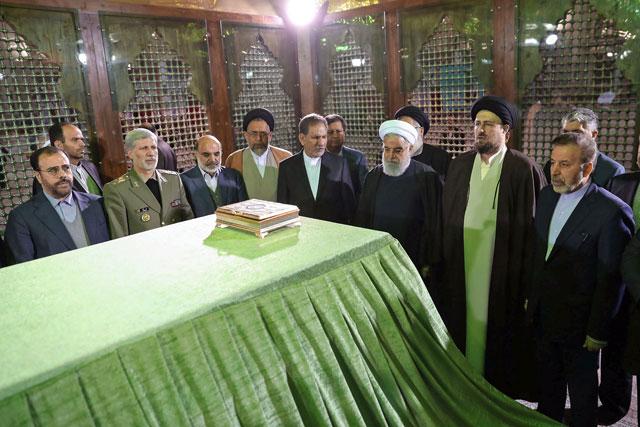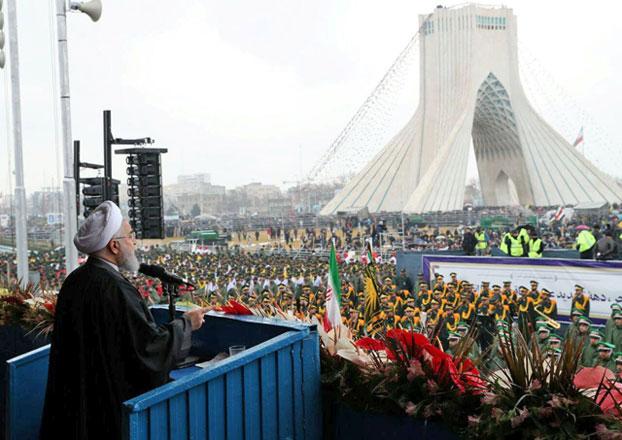You are here
Forty years on from Iran’s revolution: a judge’s tale
By Reuters - Feb 07,2019 - Last updated at Feb 07,2019

Traffic in evening rush hour moves slowly past a huge mural of founder of Islamic revolution Ayatollah Khomeini in central Tehran, Iran, on January 3, 2005 (Reuters photo)
DUBAI (Reuters) — Like many Iranians, retired judge Mohammad Reza made big sacrifices to help Ayatollah Ruhollah Khomeini launch his Islamic Revolution, enduring torture in prison for handing out leaflets calling for an end to the shah’s long dictatorship.
When Khomeini returned from exile in Paris on a special Air France charter to millions of ecstatic supporters on February 1, 1979, Mohammad Reza, now 72, was among the crowds at Tehran’s Mehrabad International Airport.
‘‘I still remember crying and chanting ‘as the demon left, the angel arrived’,’’ he said by telephone from his home in Tehran, declining to give his family name for security reasons.
The revolution which swept Iran 40 years ago this month united influential bazaar traders, intellectuals and people of all classes against the US-backed Shah Mohammad Reza Pahlavi’s lavish lifestyle, secret police and Western-style social and economic reforms.
Iran’s leaders still chant the trademark ‘‘Down with America’’ slogan of the revolt, sometimes in front of vast crowds, but they no longer inspire Mohammad Reza, and some other aged revolutionaries, who are now among the most vocal critics of the clerical leadership.
First Vice President Eshaq Jahangiri said the revolution had brought Iranians independence, freedom and justice in a speech this week to mark its anniversary on Monday. ‘‘Thanks to it, people were able to govern their destiny,’’ he said.
Mohammad Reza noted that freedom, independence and social justice were the gains the Ayatollah promised, but said using those words was now out of the question for ordinary people.
‘‘You can get arrested today if you repeat the Imam’s [Khomeini’s] values and goals publicly,’’ he said.
I was there
In 2009, Mohammad Reza said his grandson Arash was jailed and tortured in Tehran’s notorious Evin prison — where Mohammad Reza had been detained under the shah — as security forces crushed an uprising following disputed presidential elections.
‘‘At the beginning we did not know where he was or whether he was even alive,’’ the former judge said. ‘‘I used my friends from the time of the revolution who had important positions in the government to locate him.’’
Iranian officials say protests and criticism of the Islamic republic are driven by external forces intent on destroying it.
Mohammad Reza said he did not want another revolution but a return to Khomeini’s revolutionary principles.
As a junior judge under Khomeini, he said he served underdeveloped areas, hoping they would prosper in the new Iran. ‘‘I helped the revolution in my own way. By helping the poor.’’
Images of the turbaned Khomeini that now plaster walls across Iran and are held aloft by pro-government demonstrators remind him of the man he fought for in Iran’s eight-year war with Iraq, which claimed a total one million lives. His son-in-law lost a leg in the conflict.
‘‘Whenever the revolution needed me, I was there. My wife and my daughters cooked for soldiers during the war,’’ he said.
After retiring 10 years ago, he opened a small grocery shop.
‘‘I know many people who cannot even buy basic goods for their families. They come to my shop and I give them those goods,’’ he said. ‘‘We did not do the revolution to make a group of elite rich.’’
The authorities have acknowledged there is corruption in Iran but say they are tackling it.
Under decades of rule by the shah, the self-proclaimed ‘‘king of kings’’, a huge gap emerged between rich and poor: a 1971 party for world leaders in a specially created oasis only served to highlight the gulf.
During months of increasingly violent protests, Iranians chanted ‘‘Death to shah’’ before the shah and his wife, Empress Farah Pahlavi, left Tehran and flew to Aswan to Egypt on January 16, 1979.
Now, much smaller numbers of protesters call for ‘‘Death to dictator’’ during demonstrations against economic hardships they blame on President Hassan Rouhani, Supreme Leader Ayatollah Ali Khamenei and the Revolutionary Guard, who have extensive business interests.
The country is engaged in costly proxy conflicts in Iraq, Syria and Yemen, but has struggled economically since President Donald Trump withdrew Washington from the 2015 nuclear deal last year and reimposed sanctions.
Prices of bread, cooking oil and other staples have soared and the value of the rial currency has plunged.
In January, Rouhani said Iran is facing its worst economic crisis since the shah was toppled. The World Bank anticipates inflation in Iran jumping to 23.8 per cent in 2018-19 from 9.6 per cent in 2017-18, and to 31.2 per cent in 2019-20.
Last year, Iran cracked down on protests over poor living standards in over 80 cities and towns that posed the most serious challenge to its clerical leadership since the 2009 revolt. Khamenei blamed ‘‘enemies of the Islamic republic’’.
Small, sporadic protests continue over issues such as unpaid wages but nothing on the scale of last year.
Mohammad Reza said he sympathised with the demonstrators. ‘‘Their wages weren’t paid. They cannot pay their rents,’’ he said.
Living with his wife and two daughters and their families in a small house in southern Tehran, he is nostalgic for the hopeful early days of the revolution which ended Persia’s 2,500-year-old Peacock Throne.
But more than three-quarters of the population of 85 million is under the age of thirty, a generation Mohammad Reza said was less influenced by the revolutionary era that forms the bedrock of the clerical establishment.
‘‘When I see how this system is pushing our young generation away from Islam and the pillars of the revolution, I feel sad and desperate,’’ he said.
Related Articles
TEHRAN — Ayatollah Ruhollah Khomeini was an austere and charismatic cleric who became an icon of the 20th century for standing against the W
DUBAI — Hundreds of thousands of Iranians marched and some burned US flags to mark the revolution's 40th anniversary on Monday as Tehran sho
TEHRAN — The victory of the Islamic Revolution in Iran was an earthquake that upended the political order in the Middle East, and the afters













